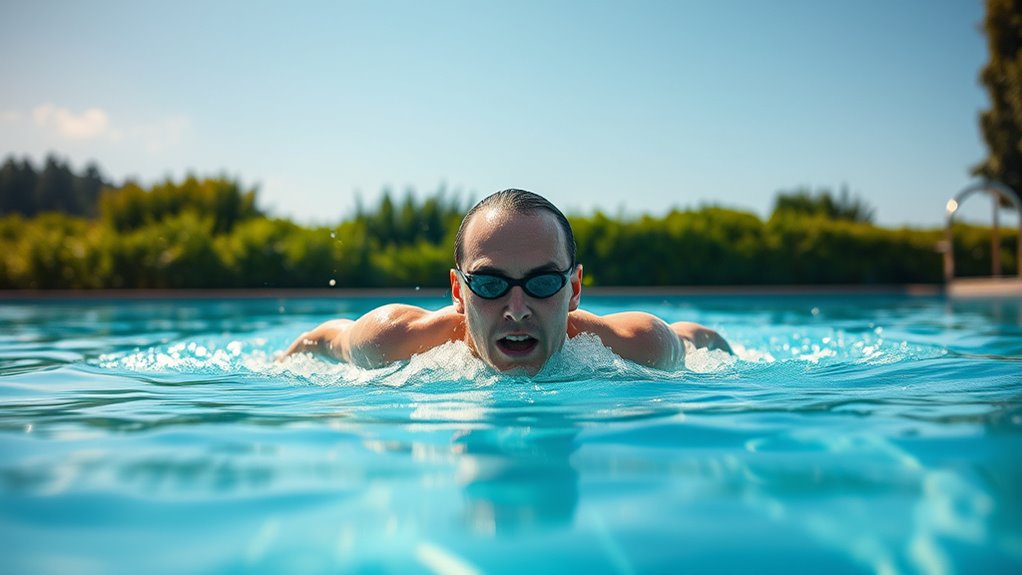Immersing yourself in water helps you stay present, pulling focus away from worries and promoting calm. By concentrating on your breath and smooth movements, you’ll activate calming patterns that soothe your nerves. Repeating gentle strokes and deep breaths creates a rhythmic flow, turning swimming into a moving meditation. Over time, this practice builds resilience and relaxes your mind outside the pool. Keep exploring how swimming can turn into a powerful tool against anxiety.
Key Takeaways
- Immersing in water creates a calming, present-focused experience that reduces anxiety through mindfulness.
- Controlled breathing during swimming activates relaxation responses, calming nerves quickly.
- Rhythmic strokes and breathing patterns induce meditative states, easing stress and calming the mind.
- Focusing on sensations and water resistance enhances body awareness, promoting mental clarity.
- Regular swimming builds long-term resilience, making it easier to manage anxiety outside the pool.

Swimming has long been recognized as a powerful way to reduce anxiety and improve mental well-being. When you immerse yourself in the water, it’s not just about physical exercise; it’s an opportunity to practice mindfulness techniques that help center your mind and calm your nerves. The sensation of water enveloping your body creates an immersive experience that pulls you into the present moment. As you focus on your movements and sensations, you naturally shift attention away from worries and intrusive thoughts. This mindfulness approach can be incredibly effective in reducing anxiety levels, especially when combined with intentional breathing exercises.
Once you’re in the pool, take a moment to slow down your breathing. Deep, controlled breaths help activate your parasympathetic nervous system—the part responsible for relaxation. You can try inhaling slowly through your nose for a count of four, holding your breath briefly, then exhaling gently through your mouth for a count of six. Repeating this pattern not only calms your nervous system but also sharpens your focus. Many swimmers find that synchronizing their breath with their strokes creates a rhythmic pattern that further grounds their mind and body. This simple act of controlling your breathing during swimming turns your workout into a moving meditation, helping to ease anxiety and promote mental clarity.
As you continue to swim, pay attention to your body’s movements and the water’s resistance. This focus on physical sensations is a form of mindfulness that prevents your mind from wandering back to stressful thoughts. You might also incorporate specific breathing exercises during your swim, such as inhaling deeply during a stroke and exhaling fully during the glide phase. These techniques deepen your relaxation response and foster a sense of calm that can linger long after you leave the pool. By practicing mindfulness and breathing exercises regularly in the water, you train your brain to associate swimming with relaxation, making it easier to access this calm state in everyday life.
Moreover, the repetitive nature of swimming strokes and breathing patterns creates a meditative rhythm that soothes your mind. The combination of physical activity, mindful awareness, and deliberate breathing helps break the cycle of anxiety. Over time, you’ll notice that these techniques become more natural, allowing you to harness their calming effects even outside the pool. Whether you’re swimming laps or floating peacefully, the deliberate focus on your breath and sensations makes swimming an effective tool for managing anxiety and fostering mental resilience. Incorporating mindfulness techniques into your routine can enhance the overall mental health benefits of swimming and promote long-term emotional well-being.
Frequently Asked Questions
Can Swimming Help With Chronic Anxiety Disorders?
Swimming can help with chronic anxiety disorders by promoting relaxation and reducing stress. When you focus on mindfulness techniques during your swim, you shift your mind away from worries. The water temperature also plays a role; warm water relaxes muscles, while cooler water can invigorate. Regular swimming encourages deep breathing and mindfulness, which are effective tools for managing anxiety, helping you feel calmer and more in control.
Are Certain Swimming Strokes More Effective for Reducing Anxiety?
Certain swimming strokes can be more effective for reducing anxiety because they promote better breathing techniques and comfort in water temperature. For example, relaxed backstroke allows you to focus on steady breathing, helping calm your nerves. Warm water generally relaxes muscles and eases tension, making your swim even more calming. Find a stroke that feels natural, stay mindful of your breathing, and adjust water temperature to maximize anxiety relief.
How Quickly Can I Expect Anxiety Relief After Swimming?
Some believe that relief from anxiety can be almost immediate after swimming, thanks to the calming effects of breathing exercises and cold water immersion. When you plunge in, your body responds quickly by releasing endorphins, which lift your mood. Many people notice reduced anxiety within minutes, especially after practicing deep breathing during your swim. So, with consistent swimming, you might start feeling calmer in just a few moments.
Is Swimming Safe for People With Physical Disabilities?
Swimming can be safe for people with physical disabilities when adaptive techniques and water accessibility are considered. You should work with trained instructors who understand your specific needs and can modify exercises accordingly. Accessible pools with ramps, lifts, and other accommodations make it easier to enjoy the benefits of swimming reliably. Always consult with your healthcare provider to confirm swimming suits your health condition and to develop a tailored, safe routine.
Do Age or Fitness Level Affect Swimming’s Calming Benefits?
Like Odysseus facing the sea, you might wonder if age factors or fitness considerations influence swimming’s calming effects. The truth is, swimming benefits everyone, regardless of age or fitness level. It’s gentle on joints, adaptable, and can be tailored to your needs. Whether you’re young or old, fit or just starting, immersing yourself in water helps reduce anxiety and promotes relaxation—making it a universal remedy for calming nerves.
Conclusion
So, next time anxiety feels overwhelming, remember that a simple plunge in the pool can be your secret weapon. Like a gentle wave crashing over stress, swimming washes away worries and calms your mind. It’s not just exercise; it’s a soothing escape, a moment of peace amid chaos. Immerse yourself, and let the water carry your fears away—because sometimes, the quickest way to find calm is to surrender to the embrace of the pool.










